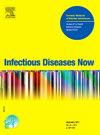The 2024 cholera outbreak in Mayotte. Clinical and biological factors associated with severe forms of the disease in an observational cohort of 206 patients
IF 2.2
4区 医学
Q2 INFECTIOUS DISEASES
引用次数: 0
Abstract
Objective
In 2024, the island of Mayotte (France) was affected by a cholera outbreak. The objective of this study was to identify clinical and laboratory criteria associated with severity (defined as hypovolemic shock and/or severe acidosis) in view of improving patient triage and therapeutic management in subsequent outbreaks.
Methods
From March 18 to July 12, 2024, we screened 215 patients with cholera (positive stool PCR). We excluded five patients who died outside hospital (no data, lethality = 2.3 %) and four patients for whom no data were available. We ultimately enrolled 206 patients. Severe forms of cholera were defined as the presence of at least one of the following three objective criteria: arterial hypotension; and/or neurological impairment (GCS < 14) (hypovolemic shock); and/or venous pH < 7.20 (severe acidosis) at first medical assessment.
Findings
Median patient age was 19 years (8–32 years), and 83 patients (40 %) presented with a severe form, which often consisted in fever (n = 13/83, 13 % vs. n = 6/123, 5 %, p = 0.04), vomiting (n = 71/83, 86 % vs. n = 79/123, 64 %, p < 0.001), a higher stool output (8 (4.5–10) vs. 4 (2–6) stools on day 1, p < 0.001) and severe hemoconcentration (Ht = 54 (47–60) vs. 43 (38–50), p < 0.001). In multivariate analysis, only hemoconcentration was associated with significantly greater severity (OR 95 % CI = 1.12 [1.04–1.21], p < 0.001).
Conclusion
Cholera is a toxin-mediated infection responsible for severe, occasionally fatal acute watery diarrhea. Severity is associated with neurological impairment, metabolic acidosis, and hemoconcentration. Triage and care of these patients are absolutely essential means of preventing death.
2024年马约特霍乱爆发。在206例患者的观察队列中,临床和生物学因素与严重形式的疾病相关。
目的:2024年,法国马约特岛发生霍乱疫情。本研究的目的是确定与严重程度(定义为低血容量性休克和/或严重酸中毒)相关的临床和实验室标准,以便在随后的疫情中改善患者分诊和治疗管理。方法:从2024年3月18日至7月12日,对215例霍乱患者(粪便PCR阳性)进行筛查。我们排除了5例院外死亡患者(无资料,致死率 = 2.3 %)和4例无资料的患者。我们最终招募了206名患者。严重形式的霍乱被定义为至少存在以下三个客观标准中的一个:动脉低血压;和/或神经功能障碍(GCS < 14)(低血容量性休克);和/或首次医学评估时静脉pH < 7.20(严重酸中毒)。发现:病人平均年龄为19 年(8-32 年),和83例(40 %)出现严重的形式,通常是在发烧(n = 13/83,13 %与n = 6/123,5 % p = 0.04),呕吐(n = 71/83,86 %与n = 79/123,64 % p 结论:霍乱是一种toxin-mediated负责严重感染,有时致命的急性水样腹泻。严重程度与神经功能损害、代谢性酸中毒和血液浓缩有关。对这些病人进行分类和护理绝对是预防死亡的必要手段。
本文章由计算机程序翻译,如有差异,请以英文原文为准。
求助全文
约1分钟内获得全文
求助全文
来源期刊

Infectious diseases now
Medicine-Infectious Diseases
CiteScore
7.10
自引率
2.90%
发文量
116
审稿时长
40 days
 求助内容:
求助内容: 应助结果提醒方式:
应助结果提醒方式:


